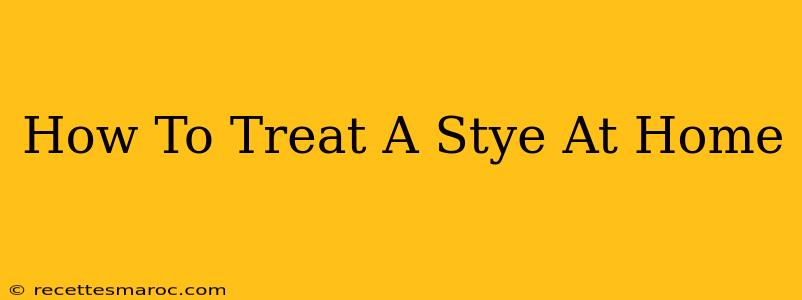A stye, or hordeolum, is a painful, red bump that forms on the eyelid. It's caused by an infected eyelash follicle or oil gland. While usually not serious, a stye can be incredibly irritating. Fortunately, many effective home treatments can help alleviate symptoms and promote healing. This guide will walk you through how to treat a stye at home, when to seek professional medical advice, and how to prevent future occurrences.
Understanding Styes: Types and Causes
Before diving into treatment, it's helpful to understand what causes a stye. There are two main types:
- External stye: This develops on the outside of the eyelid, near the base of an eyelash. It's usually caused by a bacterial infection of the hair follicle.
- Internal stye: This forms on the inside of the eyelid, within the oil gland (Meibomian gland). It's also bacterial in origin but often involves a blocked gland.
The most common cause is bacteria, usually Staphylococcus aureus. Poor hygiene, rubbing your eyes, and underlying skin conditions can increase your risk.
Effective Home Remedies for Styes
Many home remedies can help soothe a stye and speed up healing. Remember to always wash your hands thoroughly before touching your eye.
1. Warm Compresses: The Cornerstone of Stye Treatment
Applying warm compresses is the most widely recommended home treatment for a stye. The warmth helps to:
- Reduce inflammation: Heat improves blood circulation, promoting healing and reducing swelling.
- Drain the infection: The warmth can help drain pus from the stye, leading to quicker resolution.
How to apply: Soak a clean washcloth in warm (not hot!) water, wring it out, and gently apply it to the affected eye for 10-15 minutes, several times a day. Do not reuse the washcloth without washing it thoroughly.
2. Gentle Eyelid Cleaning
Keeping the eyelid clean is crucial to prevent the spread of infection. Gently cleanse the eyelid with a mild, unscented soap and warm water. Avoid harsh scrubbing, which can irritate the stye further.
3. Avoid Touching Your Eyes
This is paramount! Touching your eyes spreads bacteria and can worsen the infection or cause another stye. Try to avoid rubbing or scratching your eyes, no matter how itchy or uncomfortable they are.
4. Over-the-Counter (OTC) Eye Drops
Some OTC artificial tears can help soothe the irritation and discomfort associated with a stye. These are not a cure but can provide relief.
When to See a Doctor for Your Stye
While most styes resolve on their own within a week or two with home treatment, you should consult a doctor if:
- The stye doesn't improve after a week of home treatment.
- The stye is extremely painful or swollen.
- You develop multiple styes.
- You experience vision changes.
- You have signs of a more serious infection, such as fever or increased swelling.
Your doctor may prescribe antibiotic ointment or oral antibiotics to help clear the infection, especially if the stye is severe or recurrent. In rare cases, surgical drainage may be necessary.
Preventing Future Styes
Prevention is key! Here are some tips to reduce your risk of developing styes:
- Practice good hygiene: Wash your hands frequently and avoid touching your eyes.
- Clean your eyelids regularly: Gently cleanse your eyelids with a mild cleanser.
- Avoid sharing makeup: Bacteria can easily spread through shared cosmetics. Dispose of old mascara regularly.
- Remove eye makeup before bed: Leaving makeup on overnight can clog pores and increase the risk of infection.
By following these home treatment tips and taking preventive measures, you can effectively manage a stye and minimize its impact on your comfort and vision. Remember, consulting a healthcare professional is crucial if your stye doesn't improve or worsens.

